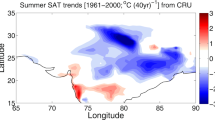Abstract
Observations indicate a surface cooling trend during the East Asian summer in recent decades, against a background of global warming. This cooling trend is re-examined using station data from 1951 to 2007, and atmospheric general circulation model (AGCM) simulations are performed to investigate the possible influence of changes in external forcing. The numerical experiments are designed to investigate the effects of four types of external forcing: greenhouse gases (GHGs), Total Solar Irradiance (TSI), ozone, and the direct effects of aerosols. Results indicate that external forcing contributes to the cooling trend over East Asia. Furthermore, GHGs, and to a lesser degree the direct effects of aerosols, are the main contributors to the cooling trend. The possible linkages between the external forcings and the cooling trend are discussed.






Similar content being viewed by others
Explore related subjects
Discover the latest articles and news from researchers in related subjects, suggested using machine learning.References
Bao Q, Wu G, Liu Y, Yang J, Wang Z, Zhou T (2010a) An introduction to the coupled model FGOALS1.1-s and its performance in East Asia. Adv Atmos Sci 27(5):1131–1142
Bao Q, Liu YM, Shi JC, Wu GX (2010b) Comparisons of soil moisture datasets over the Tibetan Plateau and application to the simulation of Asian Summer Monsoon onset. Adv Atmos Sci 27(2):303–314
Buhaug et al. (2009) Second IMO GHG study 2009. International Maritime Organization (IMO) London UK
Cheng YJ, Lohmann U, Zhang JH et al (2005) Contribution of changes in Sea Surface Temperature and aerosol loading to the decreasing precipitation trend in southern China. J Climate 18:1381–1390
Cionni I, Eyring V, Lamarque JF et al (2011) Ozone database in support of CMIP5 simulations: results and corresponding radiative forcing. Atmos Chem Phys Discuss 11:10875–10933. doi:10.5194/acpd-11-10875-2011
Duan AM, Wu GX, Liang XY (2008) Influence of the Tibetan Plateau on the summer climate patterns over Asia in the IAP/LASG SAMIL model. Adv Atmos Sci 25(4):518–528
Fröhlich C, Lean J (2004) Solar radiative output and its variability: evidence and Mechanisms. Astron Astrophys Rev 12(4):273–320. doi:10.1007/s00159-004-0024-1
Giorgi F, Bi XQ, Qian Y (2003) Indirect vs direct effects of anthropogenic sulfate on the climate of East Asia as simulated with a regional coupled climate-chemistry/aerosol model. Clim Chang 58:345–376
Held IM, Soden BJ (2006) Robust responses of the hydrological cycle to global warming. J Climate 19:5686–5699
Hu ZZ, Yang S, Wu R (2003) Long-term climate variations in China and global warming signals. J Geophys Res 108(D19):4614. doi:10.1029/2003JD003651
Huang Y, Dickinson RE, Chameides WL (2006) Impact of aerosol indirect effect on surface temperature over East Asia. Proc Natl Acad Sci 103(12):4371–4376
Huang Y, Chameides WL, Tan Q, Dickinson RE (2008) Characteristics of anthropogenic sulfate and carbonaceous aerosols over East Asia: regional modeling and observation. Adv Atmos Sci 25(6):946–959
Hurrell JW, Hack JJ, Shea D, Caron JM, Rosinski J (2008) A new sea surface temperature and sea ice boundary dataset for the community atmosphere model. J Climate 21:5145–5153
Kang IS et al (2002) Intercomparison of the climatological variations of Asian summer monsoon precipitation simulated by 10 GCMs. Clim Dyn 19:383–395
Lamarque JF, Bond TC, Eyring V et al (2010) Historical (1850–2000) gridded anthropogenic and biomass emissions of reactive gases and aerosols: methodology and application. Atmos Chem Phys 10:7017–7039. doi:10.5194/acp-10-7017-2010
Li XW, Zhou XJ, Li WL, Chen LX (1995) The cooling of Sichuan Province in recent 40 years and its probable mechanisms. Acta Meteorolgica Sinica 9(1):57–68
Li LJ, Wang B, Zhou TJ (2007) Contributions of natural and anthropogenic forcing to the summer cooling over eastern China: an AGCM study. Geophys Res Letts 34:L18807
Li JP, Zhu ZW, Jiang ZH, He JH (2010) Can global warming strengthen the East Asian Summer monsoon? J Climate 23:6696–6705. doi:10.1175/2010JCLI3434.1
Liu HN, Zhang L, Wu J (2010) A modeling study of the climate effects of sulfate and carbonaceous aerosols over China. Adv Atmos Sci 27(6):1276–1288
Liu YM et al (2012) Revisiting Asian monsoon formation and change associated with Tibetan Plateau forcing: II. Change. Clim Dyn. doi:10.1007/s00382-012-1335-y
Lohmann U, Feichter J (2005) Global indirect aerosol effects: a review. Atmos Chem Phys 5:715–737
Mahmood R et al (2010) Impacts of land use/land cover change on climate and future research priorities. Bull Am Meteorol Soc 91(1):37–46
Menon S, Hansen J, Nazarenko L, Luo Y (2002) Climate effects of black carbon aerosols in China and India. Science 297:2250–2252
Oleson KW et al (2004) Technical description of the community land model (CLM). NCAR/TN-461 + STR
Qian Y, Leung LR, Ghan SJ, Giorgi F (2003) Effects of increasing aerosol on regional climate change in China: Observation and modeling. Tellus Ser B 55:914–934
Qian Y, Gong D, Fan J, Leung LR, Bennartz R, Wang W (2009) Heavy pollution suppresses light rain in China: observation and modeling. J Geophys Res 114:D00K02. doi:10.1029/2008JD011575
Ramanathan V (1981) The role of ocean–atmosphere interactions in the CO2 climate problem. J Atmos Sci 38:918–930
Ramanathan V, Carmichael G (2008) Global and regional climate changes due to black carbon. Nat Geosci 1:221–227
Rosenfeld D, Lohmann U, Raga GB, O’Dowd CD, Kulmala M, Fuzzi S, Reissell A, Andreae MO (2008) Flood or drought: how do aerosols affect precipitation? Science 321:1039–1313
Wang SW, Zhao ZC, Chen ZH (1981) Reconstruction of the summer rainfall regime for the last 500 years in China. Geojournal 5:117–122
Wang HJ, Shi WL, Chen XH (2006) The statistical significance test of regional climate change caused by land use and land cover variation in West China. Adv Atmos Sci 23(3):355–364
Wang ZL, Zhang H, Shen XS, Gong SL, Zhang XY (2010) Modeling study of aerosol indirect effects on global climate with an AGCM. Adv Atmos Sci 27(5):1064–1077
Wu D et al (2009) Black carbon aerosols and their adiative properties in the Pearl River Delta region. Sci China Ser D-Earth Sci 52(8):1152–1163
Wu GX et al (2012) Thermal controls on the asian summer monsoon. Sci Rep 2:404. doi:10.1038/srep00404
Xu M, Chang CP, Fu C, Qi Y, Robock A, Robinson D, Zhang H (2006) Steady decline of east Asian monsoon winds, 1969–2000: evidence from direct ground measurements of wind speed. J Geophys Res 111:D24111. doi:10.1029/2006JD007337
Yang J, Bao Q, Wang X (2012a) Intensified eastward and northward propagation of tropical intraseasonal oscillation over equatorial Indian Ocean in global warming scenario. Adv Atmos Sci. doi:10.1007/s00376-012-1260-3
Yang J, Bao Q, Wang X, Zhou T (2012b) The tropical intraseasonal oscillation in SAMIL coupled and uncoupled general circulation models. Adv Atmos Sci 29(3):529–543. doi:10.1007/s00376-011-1087-3
Zhang JY, Dong WJ, Wu LY, Wei JF, Chen PY, Lee DK (2005) Impact of land use changes on surface warming in China. Adv Atmos Sci 22(3):343–348
Zhou LT, Huang RH (2003) Research on the characteristics of interdecadal variability of summer climate in China and its possible cause. Climatic Environ Res 8(3):274–290 (in Chinese)
Zhou TJ, Gong DJ, Li J, Li B (2009) Detecting and understanding the multi-decadal variability of the East Asian Summer Monsoon—recent progress and state of affairs. Meteorol Z 18(4):455–467
Acknowledgements
This study was supported by ‘973’ programs (Grant Nos. 2012CB417203, 2013CB955803, 2010CB950404), CAS Strategic Priority Research Program (Grant No. XDA05110303), the National Science Foundation of China (Grant Nos. 41023002), and the Postgraduate Innovation Program of Jiangsu China (Grant No. N0782002054).
Author information
Authors and Affiliations
Corresponding author
Electronic supplementary material
Below is the link to the electronic supplementary material.
ESM 1
(DOCX 113 kb)
Rights and permissions
About this article
Cite this article
He, B., Bao, Q., Li, J. et al. Influences of external forcing changes on the summer cooling trend over East Asia. Climatic Change 117, 829–841 (2013). https://doi.org/10.1007/s10584-012-0592-4
Received:
Accepted:
Published:
Issue Date:
DOI: https://doi.org/10.1007/s10584-012-0592-4




